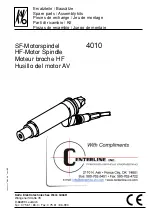
FIXED-BASE ROUTER - 054-6908-8
FIXED-BASE ROUTER - 054-6908-8
19
20
LED worklights
(fig 7)
The router motor has 3 built-in worklights located
around the collet; these provide high visibility
of the workpiece when cutting. These lights are
always “ON” when the toggle switch is in the “on”
position.
“Live tool indicator” light
(fig 8)
The router also has a green “LIVE TOOL
INDICATOR” light located on the motor housing
top cap where the power cord enters the motor
housing. This green light is always on when router
motor is plugged into a power source.
Heavy-duty edge guide
This Fixed-base Router comes with a Heavy-duty
Edge Guide. This edge guide can be used as an aid
in routing applications such as decorative edging,
straight-edge planing and trimming, grooving,
dadoing, and slotting.
To assemble the edge guide onto fixed or plunge bases, simply insert the edge-guide rods into the edge-
guide mounting slots, adjust to the desired position, and lock down using the edge-guide locking knobs.
Placing the router onto the workpiece and starting the cut
WARNING!
The direction of cutter bit rotation is clockwise. Note that, when installed upside-down in a
router table, the direction of cutter bit rotation will be counter-clockwise.
WARNING!
Before operating the router, follow all safety instructions in this Manual. Failure to do so
could result in serious personal injury.
NOTICE: Making test cuts is essential with most routing applications.
A test cut yields information
about the set-up, the speed of the router, the cutting depth and how the cutter bit reacts to the workpiece. Much
of routing is a trial-and-error process of making various adjustments, followed by test cuts, while learning all of
the router’s operational abilities. To avoid ruining good material, make the test cuts on scrap material.
The techniques for starting a cut are different for edge routing and internal routing.
DEEP CUTS
The proper cutting depth (for each pass) is always determined by the material, the size and type of
cutter bit, and the power of the motor.
Always make several progressively deeper cuts, starting at one depth and then making several passes,
increasing the cutting depth each time until the desired depth is reached.
Making a cut that is too deep will put stress on the motor and the cutter bit, and it may burn the
workpiece and dull the cutter bit. It could also “grab” too much of the workpiece and result in loss of
control of the router, causing a serious accident.
To be certain that the depth settings are as desired, always make test cuts in scrap material similar to
the workpiece before beginning the final cut.
Remember, knowing the right depth for each cut comes with routing experience.
“On/off” toggle switch
(fig 6)
The router motor is turned “ON” and “OFF” using
the toggle switch located on the top cap of the
motor housing.
The left side of the toggle switch hood (when
facing the operator) is marked “I” for “ON”, and
the right side (when facing the operator) is marked
“O” for “OFF”.
To turn the motor “ON”, push the toggle switch to
the left side, marked “I” for “ON”.
To turn the motor “OFF”, push the toggle switch to the right side, marked “O” for “OFF”.
Always hold the router and cutter bit away from the workpiece when turning the toggle switch “on”.
Only allow the router and cutter bit to come into contact with the workpiece after the router has
reached full speed. Only remove the router and cutter bit from the workpiece after turning the router
motor “off” and allowing the cutter bit to come to a complete stop. Operating in this manner will
increase the life of the toggle switch and motor, and will increase the quality of the work.
Soft start feature
The soft start feature minimizes torque twist, which is customary in larger router motors, by limiting the
speed at which the motor starts. This increases the life of the motor.
OPERA
TING INSTR
UCTIONS
OPERA
TING INSTR
UCTIONS
fig 8
fig 7
fig 6
Содержание 054-6908-8
Страница 1: ...INSTRUCTION MANUAL FIXED BASE ROUTER 054 6908 8...
Страница 21: ......







































